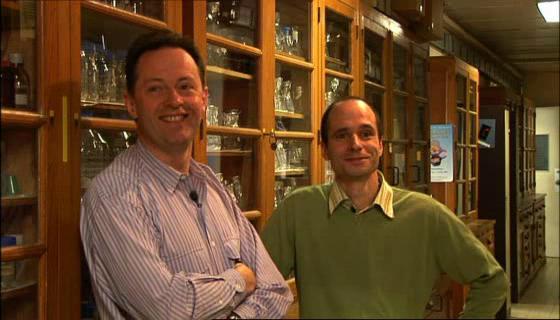Bertrand Séraphin, Guillaume Rigaut
Method for purifying biomolecule or protein complexes
As part of their research in the late 1990s, the scientists Bertrand Séraphin and Guillaume Rigaut developed a new way of purifying protein complexes that substantially simplified what had previously been a tedious procedure.
Their method - Tandem Affinity Purification (TAP) - is used to discover and describe previously unknown components of disease pathways. With a complete map of the interactions between proteins and protein complexes in a pathway, researchers can now zero in on each protein's role. Figure out which ones to disable - or to promote - and you are well on your way to a new drug-discovery opportunity.
Using yeast as their model biological system, the team found a way of isolating and purifying protein complexes by putting an artificial bipartite molecular "tag" on one of the components of the protein, thus allowing purification of the entire complex.
With TAP proving a scientific success, EMBL decided to found Cellzome, a company that started in May 2000 with only five employees. Today, some 55 people work for Cellzome at its Heidelberg facilities, while another 30 are employed at its second location in Cambridge, England.
Today, the company is active in fields including proteomics, Alzheimer's research and drug development. Among its partners are Novartis, Bayer Health Care, Johnson & Johnson and Ortho-McNeil Pharmaceutical.
How it works
Cellular pathways are made up of protein complexes. Tandem Affinity Purification (TAP) allows for the isolation and purification of these complexes under close-to-physiological conditions. It is broadly applicable to a wide range of different proteins from different sub-cellular compartments. The method of purifying these protein complexes consists of attaching an artificial bipartite molecular "tag" to one of the components of the complex, which allows the subsequent purification of the entire complex.
While such "tagging" was known before, prior methods were inefficient and yielded only impure complexes. The TAP method uses a combination of previously known "tags" in tandem, achieving an exceptionally high level of purity and thus enabling direct mass-spectrometric analysis of samples. The samples may also be analysed using other investigative techniques.
Contact
European Inventor Award and Young Inventors Prize queries:
european-inventor@epo.org Subscribe to the European Inventor Award newsletterMedia-related queries:
Contact our Press team#InventorAward #YoungInventors


